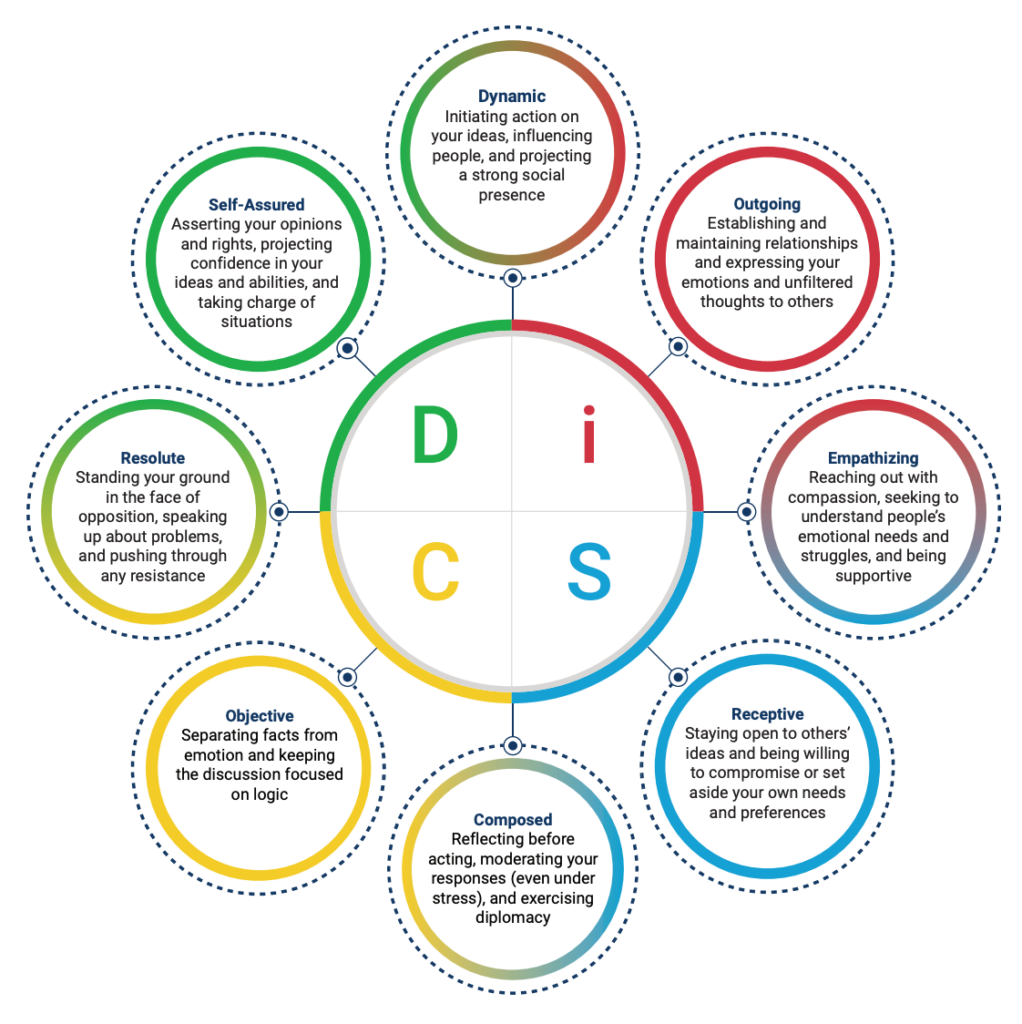Your business could employ an amazing cohort of individually motivated and talented A-players. But, if they can’t take the steps necessary to come together and work as a team, they won’t be able to realize the highest levels of success. A Deloitte study found that employees work 15% faster and do 73% better when collaborating, while research conducted by Wiley shows that most teams suffer from and aren’t able to achieve due to a critical interpersonal skills gap, which leads to a lack of trust, commitment, and accountability.
If you’ve noticed a similar performance breakdown across your work unit, the DISC assessment can help propel you in the right direction. DISC is a tool that measures and assesses an individual’s personality, specifically as it pertains to their working environment. It organizes people into one of four personality buckets based on their behaviors, communication styles, motivations, strengths, and weaknesses.
Since building a well-oiled team starts with understanding each member, learning these designations is essential. From there, you can bridge communication gaps, reduce conflicts, and work more harmoniously.

Additionally, DISC introduces team-based activities that teach employees more about their personality styles and simulate scenarios where they must learn how to effectively interact with other types and work together for a common cause. When performed correctly with effort and dedication from each individual, these teamwork tasks can help you foster an environment of trust, collaboration, and, subsequently, shared success.
Benefits Of DISC Team Building Activities
Before participating in these team-wide DISC team-building activities, each fellow worker will need to complete the ~80-question DISC analysis independently to determine which of the four personality types they most closely align with. These include Dominance, Influence, Steadiness, and Conscientiousness, each with its own set of tendencies, preferences, working pace, and level of agreeableness.
For example, your teammates who receive a Dominance classification may generally be outspoken, assertive, focused on the big picture, and prioritize achieving concrete results. Influence-type colleagues, on the other hand, are energized by new experiences. They are lively, social, and place a great deal of importance on being able to connect with and influence others. The S or Steadiness types are the rocks of the group, displaying reliability, loyalty, and consistent support. Lastly, folks on your team who are highly analytical and detail-oriented with an emphasis on expertise and competency will fall into the Conscientiousness bracket.

Knowing a person’s unique persona gives us valuable insight into how they communicate, as well as areas where they struggle versus areas where they thrive professionally. Empathy stems from understanding these characteristics, allowing team members to better connect with each personality type. With this foundation, DISC-related group activities put these learnings into action.
6 DISC Activities For Teams
Activities based on the DISC personality assessment allow teams to explore the model more deeply. Through various games and experiences, members can learn more about each personality type while simultaneously practicing soft skills like conflict resolution and creating a more empathetic team-forward atmosphere. Here are a few examples of DISC-focused team-building activities you can bring into your office environment.
Activity 1: DISC Bingo
Skip the snooze-fest slideshow presentation and get people involved with DISC Bingo instead. This is a great introductory activity for teams of six or more who are new to the DISC model. Like classic Bingo, the goal is to get five squares in a row (vertically, horizontally, or diagonally). However, the catch is that each square has traits associated with various DISC personality types.
To play, all employees will float about the room with their printed Bingo boards (DISC provides free downloadable options). During one-on-one conversations, participants will identify characteristics on each other’s boards that they align with and discuss the following questions:
- Why do you identify with the traits in these squares?
- How well does this align with what you know about your DiSC style?
Each person will sign the square they feel most connected to and then move on to a new person until they have their five in a row. This works well for entry-level DISC users because it allows everyone to share their type. It also gives insight into things they care most about and value, or conversely, things they don’t like to participate in at work, like small talk or public speaking.
If you choose to create your own boards, you can also create traits personalized to your team for even deeper and more relevant conversations.
Activity 2: DISC Role Playing
This activity allows employees to take a walk in each other’s shoes. In a group setting, select two members from the team to act out a pre-defined scenario. This could be something like a salesperson asking a boss for a raise or non-work-related, such as a couple arguing about chores. Each chosen member will also be given a personality type (Dominance, Influence, Steadiness, or Conscientiousness) to embody. They will use traits and what they know about this type to formulate their communication and responses during a few minutes of mock conversation.
Once the scene ends, the remaining team members in the audience will have a chance to guess which personality type each actor was assigned and give details as to the words and behaviors that led them to that conclusion.
This DISC activity not only allows coworkers to get into the mindset of someone who fits into a different personality type, helping them better understand how they operate, but it also allows those observing to practice identifying different styles based on social cues. The audience can also see how each style might react to stressful situations. This can help cultivate smoother communication and mitigate conflict from both perspectives.
Activity 3: Celebrity Styles Game
For something fun and lighthearted yet educational, try out a game focused on pinpointing celebrity styles. Gather in a conference room or another open space in the office (you can also complete this activity with remote workers using a virtual whiteboard). Then, hang up pictures of four to six popular celebrities or even T.V. or movie characters everyone would likely be familiar with (you can adjust the number based on time restrictions).
After a brief discussion of each well-known person’s personality, have each employee write down their guess for which DISC type they are on a post-it note and stick it to the corresponding picture. Once each celebrity has been labeled, facilitate a discussion about why everyone selected each type for each person.
Similar to the previous role-playing activity, this allows the team to become better versed in the characteristics of each DISC personality trait. At the same time, this exercise promotes healthy, open communication. Answers may not be unanimous for every celebrity. But, when colleagues have differing opinions they can find a way to talk it through calmly while still getting their points across.
Activity 4: QuikDISC Card Game
QuikDISC is a card game created to supplement and elevate the effectiveness of the DISC assessment. Each deck contains 128 cards, a quarter of which (32) are associated with each DISC personality type. Each card lists a descriptive word for that personality type, such as sociable or risk-taker.
You can use the set in many ways, but one easy activity is distributing six cards to each team member. Ask each player to discard one card which is least like them. Then, similar to the start of Bingo, everyone will begin to mingle with their coworkers.
With each conversation, employees will trade cards. After at least three trades, everyone returns to their seats and selects just two cards in their hand they associate most with (at this point, discarded cards can also be used should an employee want to swap). In the end, everyone will have time to share why they selected their two cards and also share a potential strength or weakness of this trait.
While a great deal can be learned from the cards people selected, a lot can also be learned from the cards that didn’t end up in someone’s possession. Discuss the value of these discarded traits and how their exclusion could affect the team as a whole.
This can be done as a pre-disc assessment activity or soon afterward.
Activity 5: Escape With DISC
Escape rooms are great for team building as they require immense collaboration. Why not do one—at a physical location or in the form of a board game—with a DISC twist? When working through an escape room, skills associated with each personality type are required, like analytical thinking from Conscientiousness types and leadership from Dominance types. Allow the team to solve puzzles and complete tasks while showcasing their unique problem-solving methods.
At the end of the activity, gather to talk through what occurred. Identify the ways people behaved, worked, and communicated fit into their various DISC personality styles. Discuss what went well and what could have been better to be more efficient and escape more quickly. This can help the team learn to work together towards a common goal despite behavioral differences and to reflect on strengths and weaknesses individually and as a team.
Activity 6: Team Mapping
Visualization is a key part of learning for many people. So, it can be beneficial to create a personality map for your team, plotting each member in their respective quadrant to show where they land on the DISC scale. Gather together to make this map, allowing members to place their own photo or marker based on the DISC results they received or allow DISC’s Catalyst tool to map for you.
Once the map is created, discuss whether there were any surprises and ask if there were any other reactions. If using Catalyst, you can also walk the team through the descriptions for each personality type and discuss in more detail which traits people in each group identify most with and how those traits impact their work. This visual tool makes it very clear where people lie on the spectrum. Additionally, it shows where there may be gaps and weaknesses within the team.

Incorporating DiSC Insights Into Daily Team Interactions
These DISC team-building activities can teach us a lot about ourselves, our coworkers, and our team as a whole. A quick game of Bingo can help everyone introduce their own styles, traits, and work values. Through role-playing exercises, cohorts can learn how to better resolve conflicts between different personality types. An escape room can help a team delegate tasks but also work together and use each individual’s personal strengths and abilities.
These great learning experiences can be instrumental to team growth when applied to real-world projects and scenarios. But, all is lost if you walk away from these activities and immediately start slipping into old habits. Here are some ways to make sure DISC methods show up in your office every day:
- Display your DISC team map around the office and distribute copies online to let it act as a constant reminder.
- Practice adapting your communication style to the person you are interacting with.
- Don’t stereotype or put people in a box based on their DISC personality. You can’t always assume their behaviors based on this alone.
- Leverage your team’s diverse strengths and allow members to take on tasks that align with their skills and values.
- Celebrate wins and provide constructive feedback that highlights improvement areas following a project’s conclusion.
- Hold inclusive meetings to give everyone time to contribute and make their voice heard.
- Always practice open communication and address conflict with the DISC personality types in mind.
- Commit to continuous learning with routine DISC check-in meetings and activities.
DISC Activities Build More Cohesive Teams
DISC activities offer a dynamic and impactful way to enhance teamwork and strengthen bonds among colleagues. By understanding each team member’s unique personality traits and communication styles, organizations can bridge interpersonal gaps, reduce conflicts, and build a culture of trust and collaboration.
Through engaging exercises like DISC Bingo, role-playing, and team mapping, teams gain valuable insights into their own and others’ behavioral tendencies and practice applying these lessons in collaborative scenarios. For lasting success, it’s essential to integrate these learnings into daily interactions, fostering a workplace environment where diversity of thought and effective communication drive collective growth and achievement.
Photo by La Famiglia/Shutterstock









